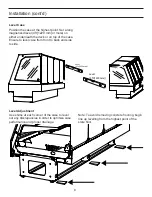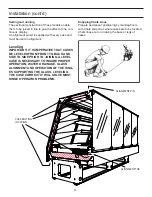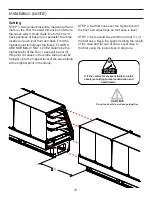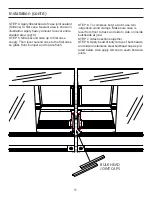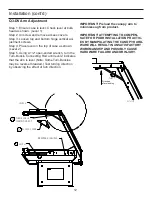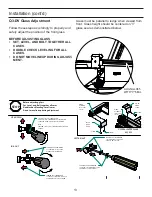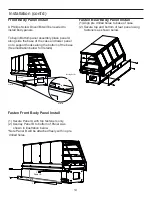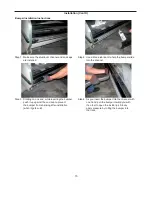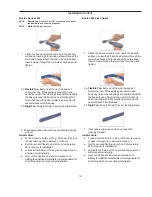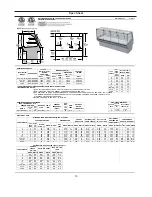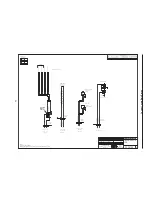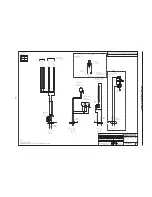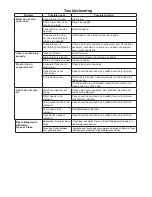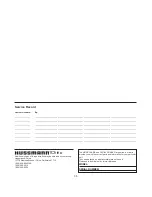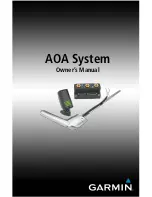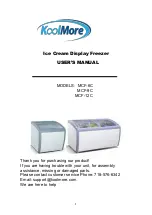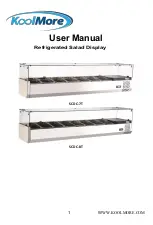
2
2
2. Temperature control should be by means of a
T-STAT and Suction Stop Solenoid at each case.
DO NOT use EPR valves, Liquid line solenoids
or electronic control devices of any kind, as these
allow temperature swings causing dehydration and
excessive energy consumption.
3. Discharge air temperature should be approximately
26°F, with between 150-200 FPM air velocity. Do not
display product directly within the air discharge.
4. Clean humidity system a minimum of every 90 days
for proper system operation.
Case Cleaning
Long life and satisfactory performance of any equipment
are dependent upon the care given to it. To insure long
life, proper sanitation and minimum maintenance costs,
the refrigerator should be thoroughly cleaned frequently.
SHUT OFF FAN DURING CLEANING PROCESS. It can be
unplugged within the case, or shut off case at the source.
The interior bottom may be cleaned with any domestic soap
or detergent based cleaners. Sanitizing solutions will not
harm the interior bottom, however, these solutions should
always be used according to the manufacturer’s directions.
It is essential to establish and regulate cleaning procedures.
This will minimize bacteria causing discoloration which
leads to degraded product appearance and signifi cantly
shortening product shelf life.
Soap and hot water are not enough to kill this bacteria. A
sanitizing solution must be included with each cleaning
process to eliminate this bacteria.
1. Scrub thoroughly, cleaning all surfaces, with soap
and hot water.
2. Rinse with hot water, but do not fl ood.
3. Apply the sanitizing solution according to
Hussmann’s directions.
4. Rinse thoroughly.
5. Dry completely before resuming operation.
Cleaning Glass and Mirrors
Only use a soft cloth and water for cleaning any glass
or mirrored components. Be sure to rinse and/or dry
completely.
Never use hot water on cold glass surfaces! It may
shatter and cause serious injury!
Allow glass surfaces
to warm fi rst.
Non-Glare Glass
The high optical clarity of this glass is possible due to
special coatings on the glass surface itself. To preserve this
coating and the optical clarity, keep the glass clean.
Water is the only solution recommended for use in cleaning
non-glare glass. The damage to the glass from improper,
caustic solutions is irreparable. In addition to cleaning the
glass with the recommended product, there are precautions
that should be taken when working and cleaning the inside
of the case.
• When cleaning the inside of the cases, we
recommend that the glass be fully opened and
covered to prevent solutions from splashing onto the
glass and ruining the coating on the inside.
Plexiglass and Acrylic Care
Improper cleaning not only accelerates the cleaning cycle
but also degrades the quality of this surface. Normal daily
buffi ng motions can generate static cling attracting dust to
the surface. Incorrect cleaning agents or cleaning cloths
can cause micro scratching of the surface, causing the
plastic to haze over time.
Cleaning
Hussmann recommends using a clean damp chamois, or a
paper towel marketed as dust and abrasive free with
210
®
Plastic Cleaner and Polish
available by calling Sumner
Labs at
1-800-542-8656
. Hard, rough cloths or paper towels
will scratch the acrylic and should not be used.
Antistatic Coatings
The
210
®
has proven to be very effective in not only
cleaning and polishing the Plexiglass surface, but also
providing anti-static and anti-fog capabilities. This product
also seals pores and provides a protective coating.
User Information (Cont'd)

